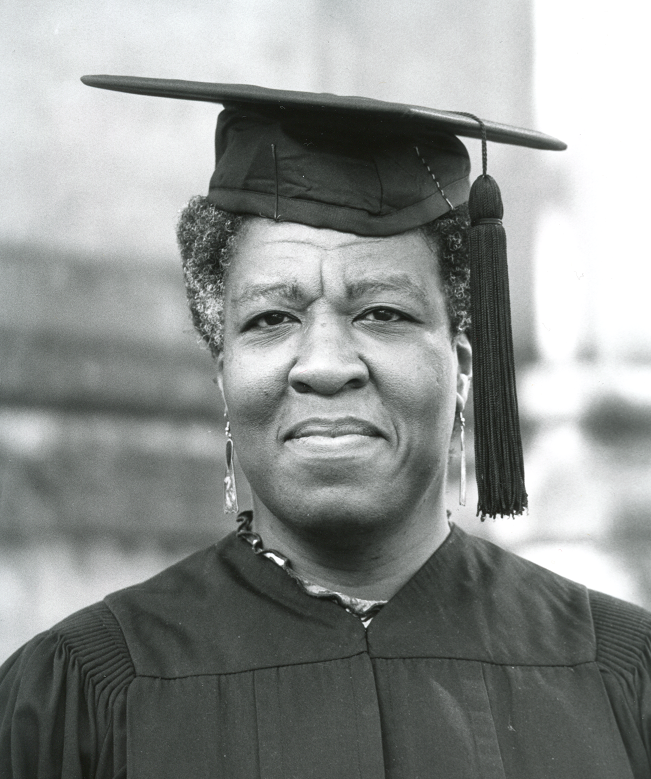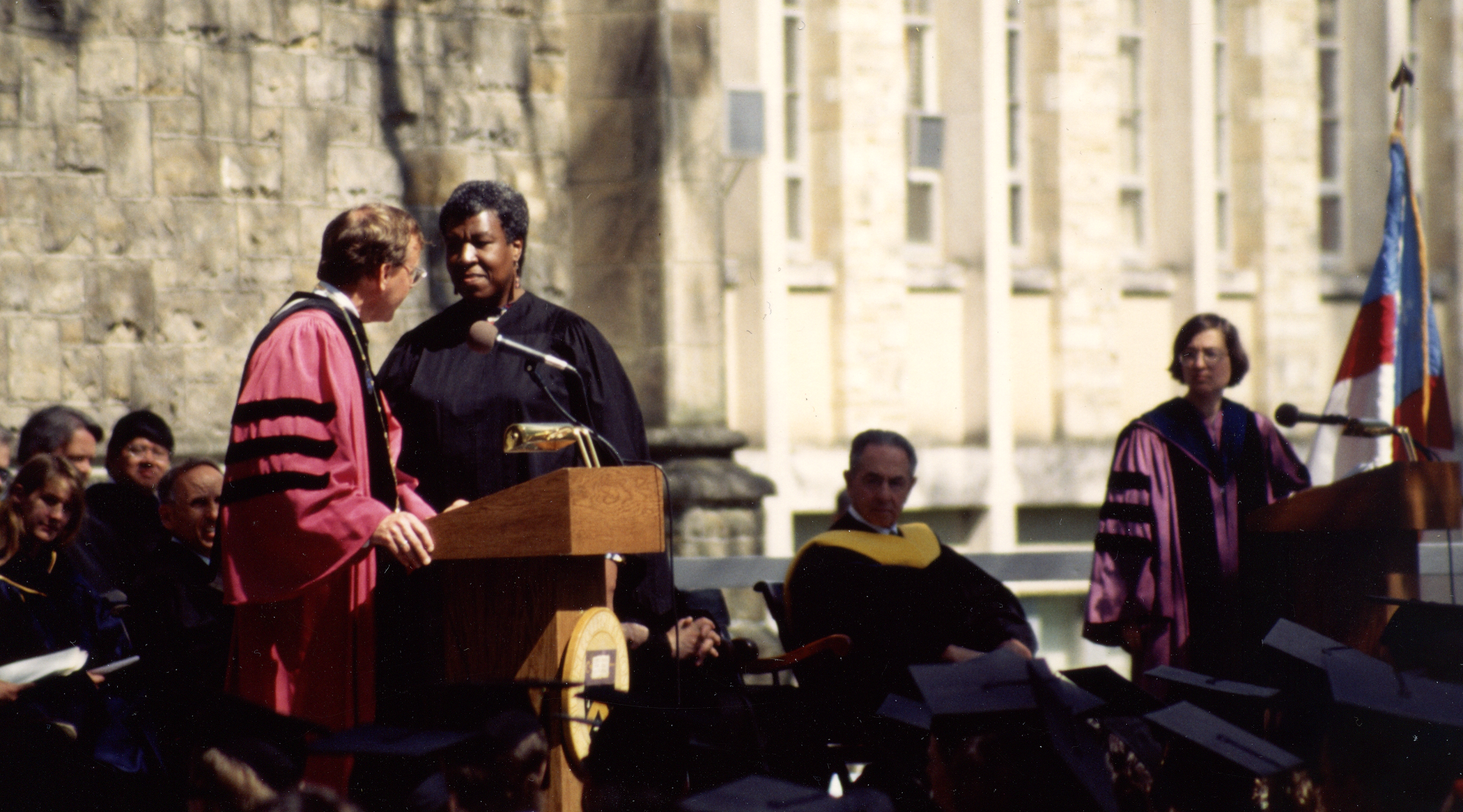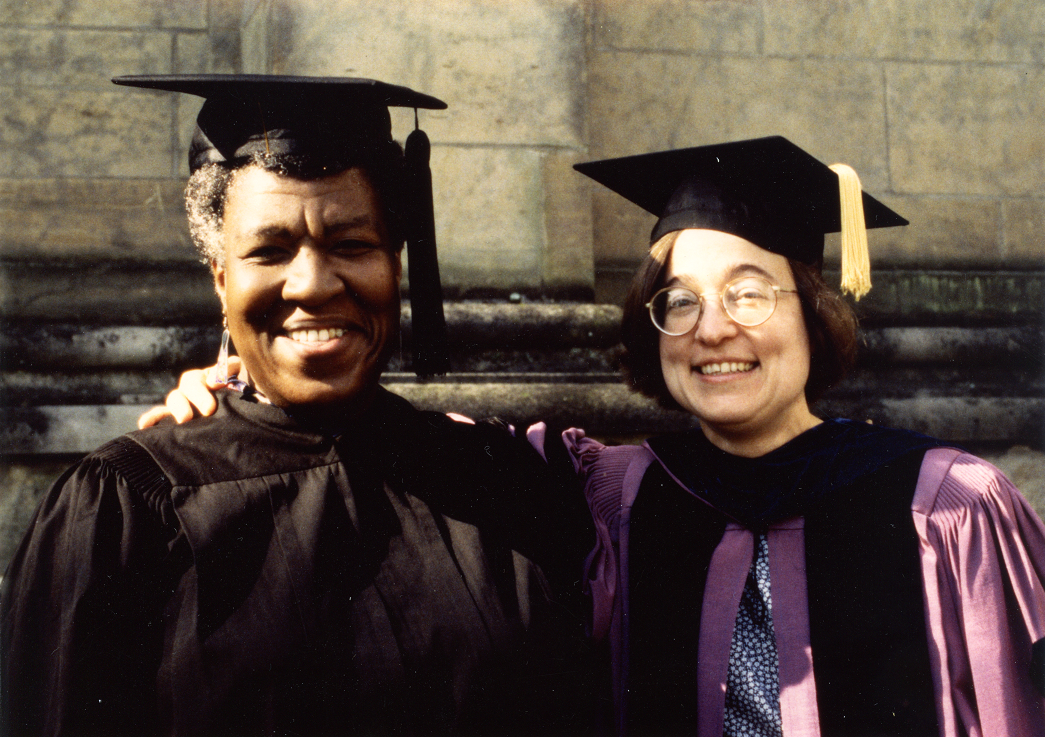|
Octavia E. Butler’s novels share with readers
her extraordinary vision of what it means to be "other,"
based on biological speculation. Her Xenogenesis trilogy,
retitled Lilith’s Brood, creates
a stunning vision of abduction and seduction by an alien
species. This vision is presented in terms remarkably
consistent with molecular biology, even predicting
developments that have occurred since the novels were
written.
As the trilogy’s first book, Dawn, opens,
the human race has nearly destroyed itself by nuclear
war--"humanicide," as Butler calls it--a fate that
seemed all too plausible in the eighties, when the book
was written, and that remains a distinct possibility if
the effects of humanity on our environment are not
reversed. The few humans who survive the war are rescued
and captured by the Oankali, a nomadic alien species
that travels through the universe seeking partner
species with whom to "trade" their own genes. The story
is told from the viewpoint of Lilith Iyapo, a human
woman whom the Oankali adopt into their family and try
to enlist in recruiting other humans. Lilith is torn
between accepting the medical enhancements and the
sexual advances of her captors while trying to help
other humans escape.
Unlike the vast majority of alien abduction
tales, Dawn actually
presents a biologically plausible explanation for why
the Oankali need to interbreed with humans--despite
their own abhorrence for the human race, which to them
appears monstrous for its combination of high
intelligence and self-destructive violence, the "human
contradiction." The Oankali have evolved specialized
organs and subcellular structures which manipulate their
own genes to maximize fitness in their environment, a
self-sustaining starship which is itself a living
organism. Paradoxically, because the Oankali are such
successful genetic engineers, they tend to engineer
themselves into an evolutionary dead end; losing all
genetic diversity, they lose the ability to adapt to
change. The only way they can recover genetic diversity
is to interbreed with an entirely new species, which
contributes new genetic strengths--and weaknesses.
Butle's story evokes the experience of an
African woman swept into slavery in the eighteenth
century. Lilith’s "Awakening" among the Oankali evokes
the dehumanization of enslavement--she is naked, has to
beg for clothing, and is denied reading materials and
other access to her own culture and history. The theme
of slavery appears frequently in Butler’s books, most
notably Kindred, in which a
Black woman travels back through time to rescue a white
man who becomes her ancestor. The heroine of Kindred struggles
with the fact that she owes her own existence as an
individual to the oppressive cultural system in which
Black women could bear children only by submitting to
the advances of their white enslavers. In a remarkable
update, today's descendants of enslaver and enslaved can
use DNA analysis to go back and confront their
Jeffersonian ancestors.
In Dawn, Lilith faces
the choice of "trading" with the Oankali to produce
half-human children, or having no family at all. Like
the slaves who bore their enslavers’ children, Lilith
obtains privileges of enhanced health and security for
herself and her future children, who will be genetically
half Oankali. The Oankali lecture her about the
superiority of their egalitarian, nonviolent lifestyle,
as opposed to the hierarchical, violent tendencies of
humans--just as Americans told their enslaved Africans
they were fortunate to be rescued from barbarism by
their "democratic" enslavers.
Like the enslaved people and their
descendants, Lilith and her children feel enormous
ambivalence about her choice. In Adulthood
Rites, Part 2 of the trilogy,
Lilith’s half-Oankali son chooses for a while to live
apart with the human "resisters," those who choose
sterility rather than join the Oankali. He at last
convinces the Oankali to provide a new home for the
resisters, where they can breed again and regenerate the
human species. The home provided is the planet Mars;
reshaped for habitability, to be sure, but all of
humanity is outcast from their own homeland, like Native
Americans forced onto a reservation. Lilith’s son risks
his life to allow humans to choose humanity; yet he
himself returns to his own hybrid heritage among the
Oankali. Throughout Butler’s work, people of various
ethnic and cultural backgrounds struggle to make such
choices.
Lilith’s ambivalence about the Oankali, and
about her own genetic heritage, echoes Butler’s own
experience in the community of writers. For many years,
Butler was one of only a few Black female writers of
science fiction. Her gifts were embraced and appreciated
by many fellow writers, and found success with
supportive publishers. Yet for publication, she had to
accept cover illustrations depicting her Black
characters as Caucasian. Butler’s success required
denial of her own racial identity, just as some of the
early women writers of science fiction had to deny their
gender by writing under male pseudonyms. Thus, she
shared Lilith’s dilemma by accepting literary success at
the cost of part of her own identity.
In the Xenogenesis books,
the transformation of humanity is accomplished by alien
biotechnology, performed by genetic engineers called ooloi,
who participate in the mating of human and Oankali.
Until recently, genetic crossing of unrelated animals
was considered untenable from the standpoint of biology.
Yet in the past decade, biologists have discovered
profound sources of genetic commonality between
organisms as distant as humans and fruit flies.
Reproductive technology has led to chimeric combinations
such as sheep and goat; and an early human embryo has
been generated from the egg of a cow. Researchers have
proposed introducing the chimpanzee’s "superior" disease
resistance genes into human chromosomes. Thus, a science
fiction writer can now propose alien interbreeding based
on reasonable biological speculation; but few writers
develop the biological basis as effectively as Butler
does.
How could a species naturally evolve a
lifestyle requiring the acquisition of genes from
unrelated species? In the years since Dawn was
published, research has revealed interesting parallels
to the Oankali in the population dynamics of living
organisms on Earth. Microbes and plants have been shown
to possess surprising capacities for "genetic trade"
with other species, even taking up naked DNA released by
dead organisms and incorporating it into their own
chromosomes. Our current view of bacteria is that, like
the Oankali, these single-celled organisms evolve so as
to keep only the limited set of genes they need for
their current environment, but retain nearly endless
capacity to acquire new genes, such as genes for
antibiotic resistance, from DNA "out there." Similarly,
plants in the natural environment have shown an
unexpected capacity to acquire herbicide resistance
genes from crop plants genetically engineered for
resistance, a discouraging sign for the future of weed
control.
Butler is one of few science fiction writers
to explore the positive potential of "bad" genes.
Genetic variants which seem defective under current
conditions may confer benefits when conditions change;
for example, a rare defect in the structure of white
blood cells confers resistance to HIV infection.
Butler’s Oankali are particularly interested in human
mutations that cause cancer. Cancer results from a
series of mutational "steps" in a few cells of the body,
leading to loss of control of growth. Yet the genes in
which these mutations occur are some of the most
critical genes of the body, vital for normal processes
of growth and development. Furthermore, some of the
viruses which cause cancer-inducing mutations have now
been developed into "vectors" of gene therapy, used to
correct or ameliorate genetic defects in human patients.
Thus, in Butler’s story, it makes sense that the Oankali
consider cancer genes to be some of the most valuable
genes for which they "trade."
From the Oankali embrace of human cancer
genes, Butler draws a broader message, that we humans
need to embrace "otherness" in ethnicities and cultures
foreign to our own, even if at first they seem to
violate our own values. But how far can--or should--our
embrace reach? Butler does not provide easy answers.
Which leads us to the question: Is there a
downside to Butler’s Oankali saviors of humanity? Do the
Oankali really represent a positive solution to the
problem of human "hierarchal tendencies," as implied by
the first book, Dawn? Is
the "non-hierarchal" way of the Oankali an absolute
improvement; or is it at once salvation and the
damnation we self-destructive humans deserve?
The concluding book of the trilogy, Imago, depicts
human-Oankali ooloi as
the ultimate post-colonialists, consummate genetic
engineers who sample the genes of all different
organisms for their "interesting taste," rather as
Americans choose to dine at ethnic restaurants. The fact
that all of Earth’s species will ultimately vanish, as
the Oankali consume the planet, does not disturb them. A
similar genetic consumerism can be seen today as biotech
companies search the dwindling rainforests for rare
species, storing their genes for useful pharmaceuticals
before the organisms vanish. Some research programs even
target indigenous human populations--ethnic groups whose
rare genes might enhance the health of Americans long
after their own races are gone. Such research
understandably draws indignant responses from those
facing extinction.
In fact, the closer one looks, the Oankali are
not our opposites, but rather an extension of some of
humanity’s most extreme tendencies. Humans disturb and
pollute our ecosystem; the Oankali will literally
consume every organic molecule of it. Humans in the
traditional Western Christian view, consider procreation
the sole function of sexuality. The Oankali—despite
Butler’s critical stance toward Christian
religions—basically share this view.
Meanwhile, the Oankali "gene trade," which
seems so fearsome in Dawn, may
be less unthinkable than we suppose. Would middle-class
Americans today ever actually trade away their own
genes, let alone their future children, as Lilith does?
One need only look to the notice boards of Ivy League
colleges, where students are invited to sell their own
eggs to infertile strangers; and many do so, to help pay
their tuition. The recipients who buy the eggs inquire
into the donors’ genetic and personal backgrounds, as
obsessively as the Oankali analyze Lilith. Ironically,
the medical process of induced ovulation jeopardizes the
future fertility of "egg donors," who may someday
require similar services to produce children of their
own. The business of egg banks and sperm banks has
become consumerized, with recipients shopping for
particular traits in pursuit of perfect offspring. The
Oankali, with their alien genetic engineering, have
become hauntingly familiar.
Adapted from Joan Slonczewski's presentation
at the Science Fiction Research Association, Cleveland,
June 30, 2000; published as “Octavia Butler’s
Xenogenesis Trilogy: A Biologist’s Response,” pp
149-155, in Alexandra Pierce and Mimi Mondal, eds. Luminescent
Threads: Connections to Octavia E. Butler. Yokine,
Australia: Twelfth Planet Press, 2017.
Octavia E. Butler’s
predictions in Parable of the Sower
and Parable of the Talents
By Jeanne
Griggs
Octavia E.
Butler’s novel Parable of the Talents, published in 1998
as a sequel to the events in the Parable of the Sower
(1993), describes the election of a president who “insists
on being a throwback to some earlier, ‘simpler’ time. Now
does not suit him. Religious tolerance does not suit him.
He wants to take us all back to some magical time when
everyone believed in the same God, worshipped him in the
same way, and understood that their safety in the universe
depended on completing the same religious rituals and
stomping on anyone who was different” (18). The president
has support for his plan to “make America great again”
(18).
Many of Butler’s other predictions from
these two novels have come true; we’re already living in
her imagined “period of upheaval…from 2015 through 2030”
(PT, 8). As California wildfires, freezing in Texas,
flooding in Missouri and articles about climate change
indicate, we’re already living in a world going through a
period of upheaval. Lauren Olamina, the protagonist of
Parable of the Sower, says that she has “watched as
convenience, profit, and inertia excused greater and more
dangerous environmental degradation.” (PS, 8). And who
living today has not?
Butler paints a picture of how climate
change could affect people in California; people of color,
in particular. Her protagonist knows that “people have
changed the climate of the world” (PS, 50) and she means
to survive instead of “waiting for the old days to come
back.” The president in Lauren Olamina’s world has
suspended “overly restrictive” (PS, 24) environmental
protections, while in the real world our president did the
same. In its last update, the New York Times listed more
than one hundred environmental rules rolled back under the
Trump administration, based on research from Harvard Law
School, Columbia Law School and other sources. The
compilers of the list prefaced it at one point by saying
that “President Trump has made eliminating federal
regulations a priority.”
Water is so scarce for the characters in
The Parable of the Sower that it “costs several times as
much as gasoline.” In their journey north, they have to
plan to travel through places where they can buy water.
They use “commercial water stations” because “anything you
buy from a water peddler on the freeway ought to be
boiled, and still might not be safe. Boiling kills disease
organisms, but may do nothing to get rid of chemical
residue—fuel, pesticide, herbicide, whatever else has been
in the bottles that peddlers use. The fact that most
peddlers can’t read makes the situation worse. They
sometimes poison themselves” (PS, 180). But “commercial
stations let you draw whatever you pay for—and not a drop
more—right out of one of their taps. You drink whatever
the local householders are drinking. It might taste,
smell, or look bad, but you can depend on it not to kill
you” (PS, 181). At one point, Lauren’s group plans to head
for a “big freshwater lake—San Luis Reservoir” pictured on
one of Lauren’s old maps, saying “it might be dry now.
Over the past few years a lot of things had gone dry. But
there will be trees, cool shade, a place to rest and be
comfortable. Perhaps there will at least be a water
station” (PS, 222). When they arrive, they find that
“there is still a little water in the San Luis Reservoir.
It’s more fresh water than I’ve ever seen in one place,
but by the vast size of the reservoir, I can see that it’s
only a little compared to what should be there—what used
to be there” (231). We can say the same about Lake Mead in
2022. Lest we believe that less arid states will fare
better, Lauren mentions that “there’s cholera spreading in
southern Mississippi and Louisiana….There are too many
poor people—illiterate, jobless, homeless, without decent
sanitation or clean water. They have plenty of water down
there, but a lot of it is polluted.”
Belief in change helps prepare Lauren to
survive, as she sees that those who look to the past—to
some possibility of living the way we used to, before
climate change--perish. If we focus only on trying to
repair or delay the damage we’ve already done to our
planet, we’re trying to live in the past—an example of
this is Lauren’s sustainable farming community, Acorn,
which is taken over by “Crusaders” who won’t return their
children until they accept the president as “God’s chosen
restorer of America’s greatness” (PT, 201).
Butler’s Parable of the Sower and Parable
of the Talents show the importance of learning to accept
change enough to work towards it, to turn our minds
towards imagining a future for our planet.
Adapted from Jeanne Griggs'
presentation at the International Conference for the
Fantastic in the Arts, Orlando, March 2021.
|





